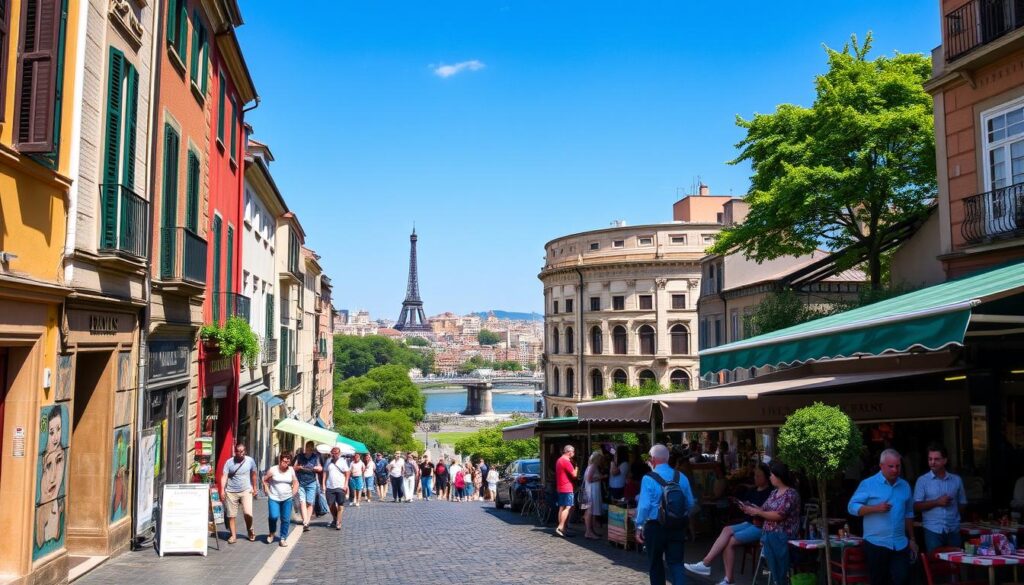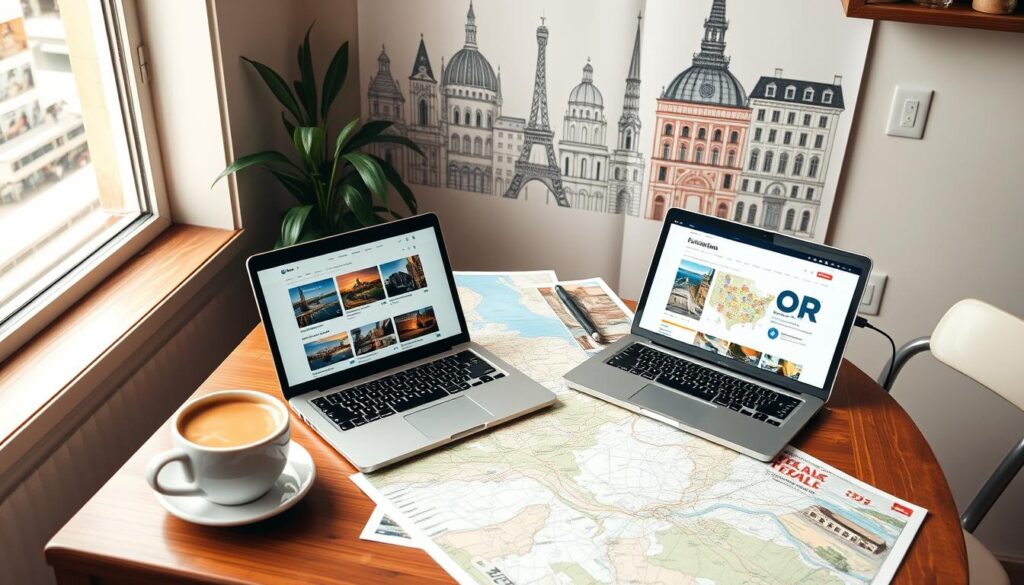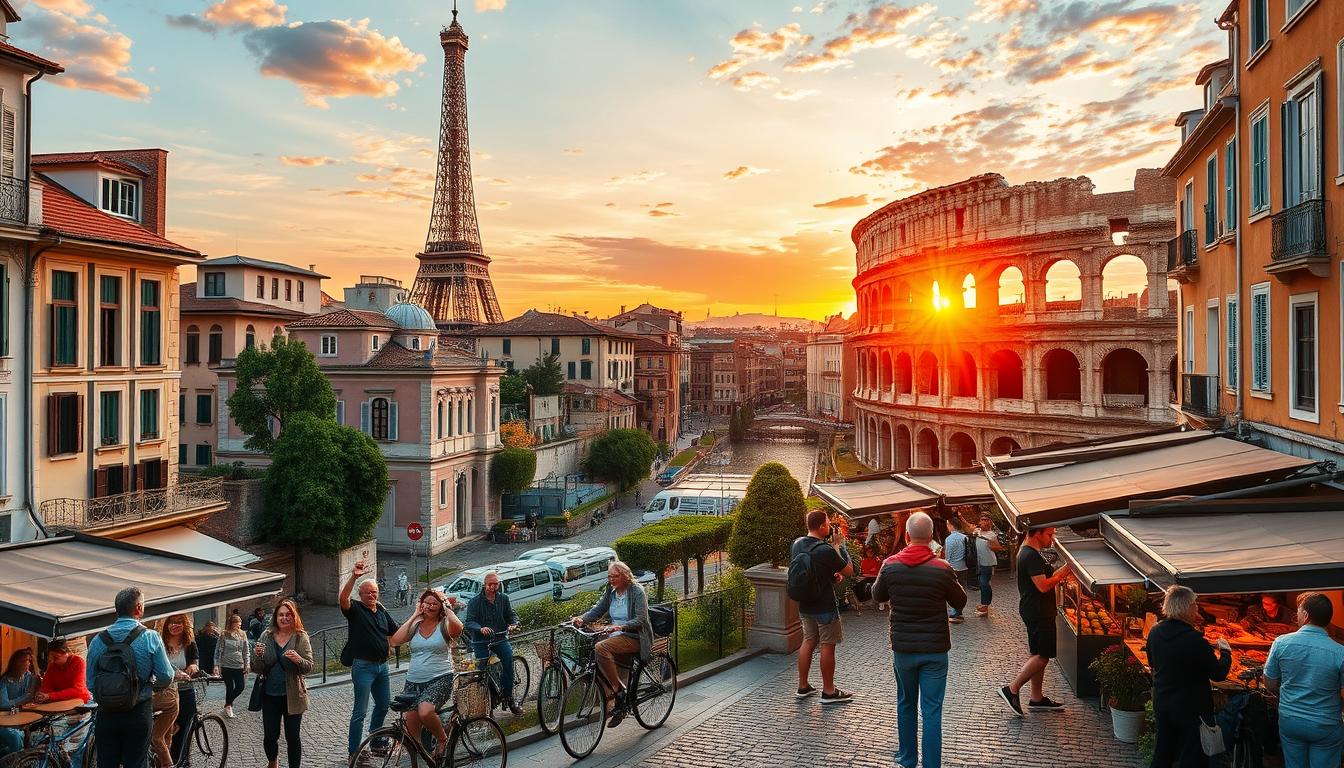Europe is full of history, cultures, and beautiful views. You don’t have to spend a lot to see it all. From Eastern Europe’s hidden spots to Western Europe’s famous cities, you can travel affordably.
Let’s look at some cheap trips to Europe. Places like Copenhagen, Dublin, and Barcelona have flights under $900. Copenhagen, for example, is $688 round-trip and has free museums.
Dublin is great for culture and has free parks. Flights are $756. Europe is full of deals.
Albania is very cheap, with daily costs of €30. Try Qoftë for €2 or seafood for €6. Sarajevo, Bosnia-Herzegovina, is also cheap, with daily costs of €28. Enjoy Bosnian coffee for less than €1 and Cevapcici for €3-€4.
Bulgaria’s Bansko is a cheap mountain getaway, with hostels from €12. Czechia is €45 a day, with Pilsner Urquell beer for €1.60. Estonia’s Baltic coast is €40 a day, mixing nature and culture.
Even in Western Europe, you can find deals. Leipzig, Germany, has hostels from €20 and Schnitzel for €8. Fuerteventura in the Canary Islands is also affordable, with cheap places to stay and eat.
Key Takeaways
- Eastern European countries like Albania and Bulgaria offer great value for budget travelers
- Central European cities like Prague and Budapest provide affordable cultural experiences
- Even Western European destinations like Leipzig have budget-friendly options
- Off-season travel to popular destinations can yield significant savings
- Local transportation and cuisine often provide the best value for money
- Free attractions and nature-based activities help keep costs down
- Flexibility in travel dates and destinations can lead to substantial savings
Understanding the Value of European Travel
Europe is full of chances for cheap adventures. You can see many places without spending a lot. With some planning, you can have fun trips that don’t cost much.
Why Europe is a popular destination
Europe is special because of its history, culture, and beauty. You can see old ruins and modern art, small villages and big cities. It’s easy to visit many places in one trip, making it great for those on a tight budget.
Debunking myths about expensive European travel
Many think traveling in Europe is expensive. But, it’s not always true. Eastern Europe is often cheaper than Western Europe. For example, a Mozart concert in Budapest costs $20, while in Vienna it’s $60. A Czech beer is just $2, much cheaper than in other places.
| City | Attraction | Cost |
|---|---|---|
| Budapest | Mozart Concert | $20 |
| Vienna | Mozart Concert | $60 |
| Czech Republic | Mug of Beer | $2 |
Benefits of exploring Europe on a budget
Traveling on a budget in Europe lets you have real experiences. Eating at local markets and street food is tasty and cheaper. Staying in hostels can also save money, with discounts of 20% to 70% on monthly rentals.
Choosing smart transportation options can also save a lot. Using public transit passes can save about $5 per ride in cities like London. These budget trips let you see more of the culture and meet locals.
Best Times to Visit Europe for Budget Travelers
Planning bargain trips to Europe needs smart timing. We found the secrets for cheap flights and affordable trips. Let’s find the best times to visit without spending too much.
Off-season Travel Advantages
From November to March, Europe’s off-season is a big savings. Hotel prices drop a lot, and airfares are cheaper than in peak season. You can see places like Rome’s Forum or Venice’s canals without the crowds.
Shoulder Season Opportunities
Spring (mid-April to mid-June) and fall (September to October) are great for budget travelers. These times have good prices and nice weather. September is especially good, with great value and comfort.
Avoiding Peak Tourist Periods
Avoid June through August for your trip. Prices go up a lot, and places get very crowded. Some cities even close in July and August as people go to the beach.
| Season | Months | Prices | Crowds | Weather |
|---|---|---|---|---|
| Off-season | November-March | Lowest | Fewest | Cold |
| Shoulder season (Spring) | Mid-April to Mid-June | Moderate | Moderate | Pleasant |
| Peak season | June-August | Highest | Most | Hot |
| Shoulder season (Fall) | September-October | Moderate | Moderate | Pleasant |
Remember, some places are busier than others. Berlin and Brussels are busy in the off-season. Scandinavia’s tourist season is short, from mid-June to late August. Picking the right time can make your trip to Europe affordable and fun.
Affordable Trips to Europe: Top Destinations
We’ve found some amazing budget-friendly European cities. They offer great value for money. You can have unforgettable experiences without spending a lot.

Eastern Europe is very affordable. Places like Budapest, Krakow, and Belgrade have rich history and fun nightlife. They also have cultural attractions at low prices. Here are some top picks:
- Budapest, Hungary: Famous for affordable thermal baths
- Krakow, Poland: Inexpensive accommodation and food
- Belgrade, Serbia: Lively nightlife and cultural scene
- Sofia, Bulgaria: Unique architectural experiences
- Tbilisi, Georgia: Budget-friendly gateway to the Caucasus
Southern Europe also has great deals. Porto, Portugal, and Zagreb, Croatia, are sunny and affordable. An Airbnb in Porto costs about $103 per night. Zagreb is even cheaper at $66.
| City | Avg. Airbnb Price (1 bed) | Avg. Pint Price |
|---|---|---|
| Porto, Portugal | $103 | $2.25 |
| Zagreb, Croatia | $66 | $2.39 |
| Bucharest, Romania | $59 | $1.94 |
| Belgrade, Serbia | $51 | $2.01 |
Timing is important for finding the best deals. Southern Europe is busiest from June to September. But May and October are sunny and cheaper. Northern Europe’s peak is shorter. Fall and spring are good for saving money.
Budget-Friendly Transportation Options
Exploring Europe on a budget is easy. We found many cheap ways to travel. These options will help you save money.
Low-cost Airlines and Flight Deals
Flights on a budget are great for long trips. Airlines like Ryanair start at just 10 EUR. Plan ahead to get the best prices.
Use Rome2Rio and Omio to find cheap routes. They mix different travel ways to save you money.
Rail Passes and Train Travel Tips
Trains in Europe are scenic and affordable. Here are tips to save money:
- Get a Eurail pass for lots of travel
- Try country-specific passes, like Switzerland’s half-fare card
- Book night trains to save on hotels
Bus Services for Budget-Conscious Travelers
Buses are cheap for traveling Europe. FlixBus starts at 5 EUR. For a fun ride, try BlaBlaCar in 20 European countries.
| Transport Option | Starting Price (EUR) | Coverage |
|---|---|---|
| Budget Airlines | 10 | Long-distance travel |
| FlixBus | 5 | Most of Europe |
| Rental Cars | 25 per day | Flexible travel |
| Campervans | 60 per day | Select countries |
Walking or biking in cities saves money. It also gives you special experiences. With these tips, your European trip is ready to begin!
Accommodation Hacks for Saving Money
Finding cheap places to stay in Europe doesn’t mean you have to give up comfort. We’ve found many ways to save money on where we stay. We aim to spend $2,000 or less each month. And we often do better than that.
Cheap hostels are a hit with budget travelers. In places like Amsterdam or Berlin, you can find a bed for about $30 a night. They’re not just cheap. You also get to meet new people and use shared spaces like kitchens.
For longer stays, Airbnb Europe deals are a good choice. Booking for longer can really save you money. For example, in Split, Croatia, we got a one-bedroom apartment for about $1,100 a month. That’s less than $600 for each of us.
| Accommodation Type | Average Cost per Night | Benefits |
|---|---|---|
| Hostels | $30 | Social atmosphere, shared facilities |
| Airbnb (long-term) | $37 | Privacy, kitchen access, local experience |
| Budget Hotels | $50 | Private rooms, basic amenities |
To save more, look for places in less touristy areas. These spots usually cost less and give you a real local feel. Also, check if your place offers free breakfast or other perks to stretch your budget even more.
Eating on a Budget: Culinary Adventures Without Breaking the Bank
Europe is full of tasty foods, and we’ll show you how to enjoy them without spending a lot. You can find great deals in markets and cafes. Let’s dive into the world of cheap eats in Europe.
Local Markets and Street Food
Street food in Europe is a great choice for those on a budget. Places like Florence’s Mercato Centrale offer tasty meals at low prices. Street vendors have yummy food for just a few dollars, making them a top pick for budget travelers.
Budget-Friendly Restaurants and Cafes
Look for ‘Menu del Dia’ or ‘Plat du Jour’ specials for big savings on lunch. Many restaurants give 15-25% off with tourism cards. For a real local feel, try university cafeterias or milk bars in Poland for quick, affordable meals.
Self-Catering Options for Frugal Travelers
Shopping for groceries can cut down your food costs. Many supermarkets offer discounts on items close to expiring, like bread and produce. This lets you try new flavors while saving money. But, cooking your meals might not always be the cheapest in Europe, unlike in Asia.
| Dining Option | Average Cost | Benefits |
|---|---|---|
| Street Food | $3-$5 | Authentic, quick, diverse options |
| Local Markets | $5-$10 | Fresh ingredients, cultural experience |
| Budget Restaurants | $10-$15 | Sit-down meals, local specialties |
| Self-Catering | $5-$8 per meal | Control over ingredients, flexible meal times |
By mixing these options, you can enjoy Europe’s food scene without spending too much. Eating like a local not only saves money but also gives you a true taste of European culture.
Free and Low-Cost Attractions in European Cities
Traveling Europe on a budget doesn’t mean missing out. We’ve found many free attractions across Europe. These are great for those who love to explore without spending much.
Many cities offer free walking tours. These tours teach you about local history and culture. In London, you can visit the British Museum for free. Copenhagen’s National Museum of Denmark is also free.
Public parks and gardens are perfect for saving money. In Paris, visit the Luxembourg Gardens. In Madrid, check out Retiro Park. These places offer a calm break from the city.
Look for free days at famous spots. Many museums give free entry on certain days. This is a smart way to see great art without spending a lot.
| City | Free Attraction | Average Hotel Rate |
|---|---|---|
| London | British Museum | Varies |
| Copenhagen | National Museum of Denmark | $215 |
| Barcelona | La Mercè Festival | Varies |
| Lisbon | Various Free Walking Tours | $240 |
Don’t miss free events like London’s Notting Hill Carnival. Barcelona’s La Mercè festival is also a must-see. These events show off local culture and are great for budget travelers.
Money-Saving Tips for European Travel
Going to Europe doesn’t have to cost a lot. We’ve got great tips to help you save money. You can learn how to exchange money wisely and find budget-friendly travel options. These tips will help you enjoy Europe without spending too much.
Currency Exchange Strategies
Avoid using airport kiosks for exchanging money. ATMs and local banks give better rates. Some U.S. banks even cover ATM fees abroad, making it cheaper to get cash.
Using Travel Rewards and Points
Use travel rewards credit cards to earn points. These points can get you free or cheaper travel. Look for cards with travel insurance and no foreign fees for more savings.
Budget Apps and Tracking Expenses
Use budget apps to track your spending. They help you stay within your budget. Many apps also convert money, making it easier to understand costs in Europe.
| Budget Travel Hack | Potential Savings |
|---|---|
| Travel off-season (October-April) | Up to 50% on accommodations |
| Use budget airlines | 30-70% compared to major carriers |
| Stay in hostels or B&Bs | 40-60% compared to hotels |
| Use city passes for attractions | 20-30% on entrance fees |
With these budget tips, you can save a lot while exploring Europe. Look for free days at museums and attractions. With smart planning, your trip can be both fun and affordable.
Planning Your Itinerary: Balancing Cost and Experience
Planning a trip to Europe can be fun but also a bit hard. We’ll help you make a trip that’s easy on your wallet but full of great experiences. The trick is finding the right mix of famous places and secret spots.
First, plan your route to avoid going back and forth. This saves money on travel and lets you see more. Stay in cheaper cities and take day trips to more expensive places. For instance, live in Prague and explore the Czech Republic nearby.

Combine famous spots with places not many people visit. This makes your trip interesting and affordable. For every paid spot, find something free to do. Many cities offer free walking tours or museums with no cost.
Traveling during the off-season can save you a lot. You can find cheaper flights and places to stay. Eastern Europe is often cheaper than Western Europe or Scandinavia.
| Expense Category | Budget Range (per day) | Money-Saving Tips |
|---|---|---|
| Accommodation | $15 – $300+ | Consider hostels or budget hotels |
| Food and Drink | $25 – $100 | Try local markets and street food |
| Transportation | $0 – $30 | Use public transit or walk |
| Attractions | $0 – $100 | Look for free museums and city tours |
A good plan balances spending and fun. By choosing wisely and mixing paid and free activities, you can have a memorable and budget-friendly trip to Europe.
Conclusion
Traveling to Europe on a budget is possible. We’ve shown many ways to see Europe’s culture and history without spending too much. You can travel to Europe without breaking the bank by choosing the right times and places to stay.
Travelers can spend $100 to $300 a day in Europe. This includes where you stay, eat, and what you do. Staying in hostels and eating street food can save a lot of money. Eurail passes cost between $200 to $500, and spending $10 to $20 a day on sightseeing is worth it.
Planning is important for a budget-friendly trip to Europe. Use tools like Skyscanner for flights and Rome2Rio for travel inside Europe. Traveling during the shoulder seasons can save a lot on hotels and flights. With good planning and a sense of adventure, you can have great memories in Europe without spending too much.


